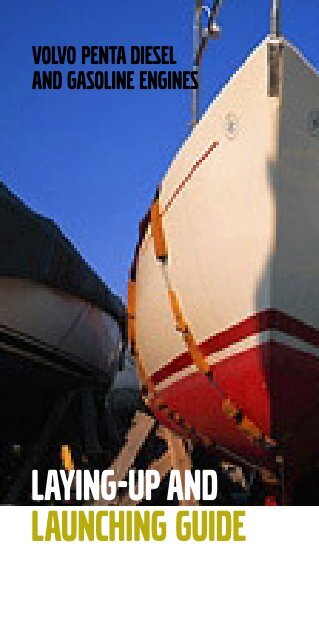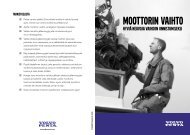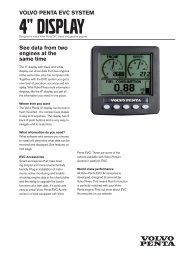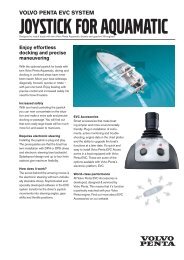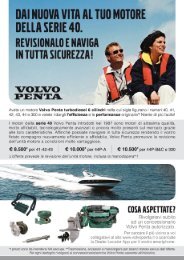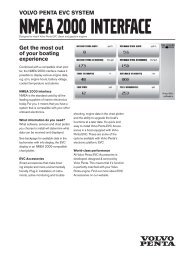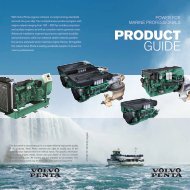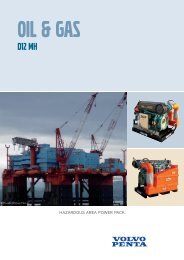LAYING-UP AND LAUNCHING GUIDE - Volvo Penta
LAYING-UP AND LAUNCHING GUIDE - Volvo Penta
LAYING-UP AND LAUNCHING GUIDE - Volvo Penta
Create successful ePaper yourself
Turn your PDF publications into a flip-book with our unique Google optimized e-Paper software.
VOLVO PENTA DIESEL<br />
<strong>AND</strong> GASOLINE ENGINES<br />
<strong>LAYING</strong>-<strong>UP</strong> <strong>AND</strong><br />
<strong>LAUNCHING</strong> <strong>GUIDE</strong>
2<br />
TIME WELL INVESTED<br />
This guide covers most of the items to be checked<br />
and seen to on your engine and drive when laying<br />
up and launching. Although it won’t take more than<br />
a couple of hours of your time each year, your<br />
engine will run more reliably and economically and<br />
use less fuel, with less chance of unnecessary<br />
breakdowns. Life at sea will be safer.<br />
You will find more detailed information in your engine<br />
instruction book and our do-it-yourself manuals.<br />
Or consult your authorized <strong>Volvo</strong> <strong>Penta</strong> dealer, he will<br />
be pleased to carry out your servicing and maintenance,<br />
if you do not wish to do it yourself. Certain<br />
complicated jobs are, of course, best left to an<br />
authorized dealer since they call for both specialized<br />
knowledge and special tools.<br />
Always use Genuine <strong>Volvo</strong> <strong>Penta</strong> Parts. That way<br />
you can be confident that the parts you use will be<br />
of the right quality and fit perfectly. And make sure<br />
you have tools on board and that your on board<br />
repair kit is complete.<br />
Remember the environment –<br />
collect any oil, coolant, degreaser,<br />
paint, etc., and dispose of them<br />
in the proper containers.<br />
The time intervals mentioned by us are only general and can vary<br />
between different engine types. The operator's manual will give you<br />
the proper intervals for your particular engine. However, entirely<br />
different intervals apply, if you use the engine for commercial purposes<br />
or in very polluted waters.
Oil and oil filter changes 4<br />
Cooling system 8<br />
Thermostat 10<br />
Impeller 11<br />
Cooling water hoses/Exhaust hoses 12<br />
Drive belts 13<br />
Fuel system 14<br />
Air filter/Air intake silencer 15<br />
Electrical system 16<br />
Oil changes – drive/reverse gear 18<br />
Drive 20<br />
Propeller 22<br />
Cleaning and painting 23<br />
Ventilation 24<br />
Corrosion protection – inside the engine 25<br />
Ignition system 26<br />
This symbol represents work in<br />
connection with the laying-up season<br />
This symbol represents work in<br />
connection with the launching season<br />
� A yellow box represents warning text<br />
3
OIL<strong>AND</strong> OIL FILTER CHANGES<br />
4<br />
You should change the engine oil and oil filter after<br />
approx. 100 hours of operation, or at least once<br />
per season.<br />
Choose <strong>Volvo</strong> <strong>Penta</strong> engine oil which has good<br />
inhibiting qualities and you will not need to add<br />
any special inhibiting oil for a normal winter lay-up.<br />
A new oil filter will remove soot and metal particles<br />
from the oil and prevent unnecessary engine wear.<br />
Genuine <strong>Volvo</strong> <strong>Penta</strong> filters are tested and specially<br />
designed to suit each particular engine type.<br />
Run the engine warm before changing<br />
the oil. It is easier to do this when the<br />
boat is still in the water (it can also be<br />
done in connection with engine inhibiting).<br />
Switch off the engine and use an oil bilge pump to<br />
pump out all the engine oil through the dipstick hole.<br />
Change the oil filter and fill up with the right amount<br />
of <strong>Volvo</strong> <strong>Penta</strong> engine oil. Also change transmission<br />
oil, please refer to the ”Oil changes – drive/reverse<br />
gear” chapter. Run the engine for a while. Check for<br />
oil leaks.
Check the oil level before starting the<br />
engine.<br />
5
6<br />
COOLING SYSTEM<br />
INHIBITING SEA WATER COOLED ENGINES<br />
Regular maintenance and servicing of the cooling<br />
system is an effective way of preventing damage<br />
from overheating. It is also important to inhibit the<br />
cooling system for the lay-up season in order to<br />
avoid frost damage and corrosion.<br />
� Work on the cooling system is best carried out<br />
on land. Otherwise there is a risk of water getting<br />
into the boat.<br />
The engine and reverse gear cooling<br />
water ducts must be flushed and<br />
drained off. Detach the suction pipe<br />
from the inside of the shield on the Aquamatic drive<br />
or from the reverse gear. Connect a hose to the<br />
suction pipe and insert it in a bucket of fresh water.<br />
Make sure that the bucket is continually replenished<br />
with fresh water. Let the engine idle until it warms<br />
up enough to open the thermostat.<br />
� Never let the water pump run dry.
It is important to let the engine run<br />
for a while, in order to flush away any<br />
sludge and salt that could otherwise<br />
cause rusting. Then switch off the engine. Insert the<br />
free end of the hose into a solution of water and<br />
<strong>Volvo</strong> <strong>Penta</strong> coolant. Allow the liquid to circulate for<br />
a while, without the bucket becoming empty. Switch<br />
off the engine and replace the suction pipe.<br />
N.B. Leave the liquid in the system, as it provides<br />
good protection against freezing and corrosion.<br />
Check and clean sea water filter, if fitted.<br />
If you wish to protect the engine over a longer<br />
period than the normal lay-up time, use <strong>Volvo</strong> <strong>Penta</strong><br />
emulsifying inhibiting oil, as it is specially designed<br />
for the cooling water ducts. Follow the same procedure<br />
as above, but empty the system completely, as<br />
the liquid does not offer any protection against frost.<br />
Check that all plugs and drain cocks<br />
are fully closed.<br />
N.B. Some engines have zinc anodes on the plugs<br />
and these act as sacrificial anodes in the cooling<br />
system. An anode must be replaced when about<br />
50% of its volume has been used up.<br />
7
8<br />
COOLING SYSTEM<br />
INHIBITING FRESH WATER COOLED ENGINES<br />
Regular maintenance and servicing of the cooling<br />
system is an effective way of preventing damage<br />
from overheating. It is also important to inhibit the<br />
cooling system for the lay-up season in order to<br />
avoid frost damage and corrosion.<br />
� Work on the cooling system is best carried out<br />
on land. Otherwise there is a risk of water getting<br />
into the boat.<br />
The fresh water cooled engine has two cooling<br />
systems. The engine block and cylinder head are<br />
fresh water cooled. But the oil cooler, heat exchanger<br />
and, on some engines, exhaust pipes, are sea water<br />
cooled and should be inhibited in accordance with<br />
the section on sea water cooled engines.
Check the freezing point of the coolant<br />
with a hydrometer and top up the cooling<br />
system if necessary. The coolant mixture<br />
looses its corrosion protective qualities with time<br />
and should therefore be changed every other year.<br />
N.B. Avoid mixing different types of coolants since<br />
it drastically diminishes the corrosion protective<br />
qualities.<br />
Do not mix coolant with other additives.<br />
Check and clean sea water filter, if fitted. Inhibit the<br />
sea water cooled part of the engine in accordance<br />
with the section on sea water cooled engines (see<br />
page 7).<br />
Check the level of the fresh water<br />
system and make sure that all plugs<br />
and draining cocks are fully closed.<br />
N.B. Some engines have zinc anodes on the plugs<br />
and these act as sacrificial anodes in the cooling<br />
system. An anode must be replaced when about<br />
50% of its volume has been used up.<br />
9
10<br />
THERMOSTAT<br />
If your instrument panel has a temperature gauge<br />
you will be able to see whether the engine stays at<br />
the right working temperature or not. Excessive<br />
temperatures are often caused by blockage in the<br />
coolant intake, cooling ducts or heat exchanger, or<br />
by a defective impeller. Too low a temperature is<br />
usually caused by a faulty thermostat.<br />
Check the function of the<br />
thermostat by removing it<br />
and placing it with a thermometer<br />
in a pan of water. Heat the water and see if<br />
the thermostat opens at the temperature indicated in<br />
the operator’s manual. If not, replace the thermostat.
IMPELLER<br />
The impeller pumps cooling water through the<br />
engine cooling system. It is, therefore, an extremely<br />
vital safety feature. Replace the impeller at least<br />
every two years. However, a worn or damaged<br />
impeller must be replaced immediately. Make a<br />
habit of keeping a spare impeller, and seal for the<br />
impeller pump cover, on board.<br />
After inhibiting, unfasten the sea water<br />
pump cover and remove the impeller.<br />
Rinse it well and keep it in a tightly<br />
sealed plastic bag in a cool place during the lay-up<br />
period.<br />
Install a perfect impeller and impeller<br />
cover together with a new seal.<br />
11
12<br />
COOLING WATER HOSES /<br />
EXHAUST HOSES<br />
As rubber becomes brittle with time, you should<br />
occasionally check the hoses for any signs of cracks<br />
or damage<br />
� Leaking cooling water hoses are a safety hazard<br />
and can cause the engine to overheat or the boat<br />
to become filled with water.<br />
� Leaking exhaust hoses can cause dangerous<br />
exhaust fumes on board and allow water to get<br />
into the boat.<br />
Carefully inspect the hoses and clamps<br />
of the cooling system and exhaust<br />
system. Replace those hoses which do<br />
not feel soft and pliable. Tighten all hose clamps.<br />
Check the condition of the hoses and<br />
that all hose clamps are securely<br />
fastened.
DRIVE BELTS<br />
Check on the generator belt and the fresh water<br />
pump drive belt a few times a year to make sure<br />
that they are properly tensioned. Make sure that<br />
they are not cracked or frayed. A perfect drive belt<br />
gives a better generator charging effect while, at the<br />
same time, reducing the risk of overheating. Always<br />
keep spare belts on board. Genuine <strong>Volvo</strong> <strong>Penta</strong><br />
drive belts last much longer.<br />
Check the condition of the belts.<br />
Replace them if necessary.<br />
After replacement – tighten the belts<br />
and adjust the tension.<br />
N.B. Check the belt tension once more<br />
after a few hours running. Readjust, if necessary,<br />
according to the Operator’s Manual.<br />
13
14<br />
FUEL SYSTEM<br />
It is important, when overhauling and servicing<br />
the fuel system, to consider the safety aspects and<br />
always use Genuine <strong>Volvo</strong> <strong>Penta</strong> Parts. It is particularly<br />
important to avoid getting any dirt into the<br />
system.<br />
Fill the fuel tank for the lay-up<br />
period and you won’t have to worry<br />
about condensation in the tank.<br />
Check before you fill up that there are no special<br />
rules applicable to the site where the boat is laid up,<br />
about the quantity of fuel aboard.<br />
Venting the fuel system (see operator’s<br />
manual) and run the engine warm,<br />
while checking for leaks.<br />
� Switch off the engine immediately if you<br />
discover any leaks.
AIR FILTER /<br />
AIR INTAKE SILENCER<br />
If your engine has an exchangeable filter element,<br />
it should be changed at least once per season.<br />
An engine with a clean air filter can work more<br />
efficiently and uses up less fuel.<br />
Use Genuine <strong>Volvo</strong> <strong>Penta</strong> filters, they are specially<br />
designed and tested for each particular engine type.<br />
Change the filter element or clean<br />
the air intake silencer. Also replace the<br />
crankcase ventilation filter (if any).<br />
15
16<br />
ELECTRICAL SYSTEM<br />
Sea air, which can be very humid and salty, presents<br />
a tough environment for the electrical system to<br />
operate in. The electrical system of the engine can<br />
be affected by creeping current, oxidation and<br />
voltage drop if you do not overhaul it regularly.<br />
Make sure that the wires are undamaged and have<br />
not been subjected to bilge water. Otherwise there<br />
is a risk that leakage currents can get to the engine/<br />
drive or to the bilge water in the bilge. Serious<br />
corrosion damage can occur within a short time if<br />
leakage currents knock out the galvanic corrosion<br />
protection.<br />
� Important! A battery will be seriously damaged<br />
if discharged for longer periods. A discharged or<br />
badly charged battery can be ruined by freezing.
Remove the battery cables, clean the<br />
cable clamps and apply the appropriate<br />
type of grease to the battery poles.<br />
Check the electrolyte level and charge the batteries.<br />
Batteries discharge when not in use, so you should<br />
recharge the batteries once a month, or once every<br />
two months, depending on storage temperature.<br />
The warmer the storage conditions, the faster the<br />
discharging process. The battery can be left on<br />
board if it is fully charged.<br />
Clean and dry dirty and damp cables.<br />
Spray the connection points, contacts<br />
and fuse holders on the engine and<br />
under the instrument panel with <strong>Volvo</strong> <strong>Penta</strong> Universal<br />
Oil. Also loosen and clean any oxidized connection<br />
points.<br />
Check all fuses and make sure that<br />
there are spare fuses on board.<br />
Connect the fully charged battery and<br />
grease the poles with pole grease.<br />
17
18<br />
OIL CHANGES<br />
DRIVE/REVERSE GEAR<br />
� It is absolutely vital that you follow the safety<br />
recommendations in the operator’s manual very<br />
carefully when you work with the drive and shield.<br />
Otherwise, you run the risk of seriously hurting<br />
yourself.<br />
Change the oil in the drive/reverse<br />
gear. Be careful to use the right oil<br />
quality. Fill up to the right level and run<br />
the engine for a moment to make the oil circulate.<br />
If the old oil looks grey, it could be the result of<br />
water leaking into the drive. Contact your authorized<br />
<strong>Volvo</strong> <strong>Penta</strong> workshop if your oil looks grey.<br />
Check the oil level.
If you have an S-drive, the rubber seal between<br />
drive and engine bed has to be checked every year.<br />
If damaged, it must be replaced with a new seal<br />
immediately. Otherwise it should be changed every<br />
seventh year.<br />
19
20<br />
DRIVE<br />
When replacing the rubber bellows the drive must<br />
be dismounted first. Let your workshop deal with<br />
this. However, if you feel that you can manage the<br />
job yourself, be sure to follow the directions in the<br />
do-it-yourself manual very carefully.<br />
The bellows are subjected to tremendous wear from<br />
movement and from salt and impurities of the air<br />
and water. If water gets in via the drive joint bellows<br />
it can cause extensive direct damage and, in many<br />
cases, also costly subsequent damage. So replace<br />
the bellows regularly (at least every other year).<br />
N.B. If the boat is used in fresh water (or brackish<br />
water containing little salt) the drive anode should<br />
be replaced with a magnesium anode.<br />
Carefully check the exhaust bellow and<br />
drive joint bellow, if you have not already<br />
done so when laying up. Check that<br />
the hose clamps on the bellows are firmly tightened<br />
and lubricate the grease nipples on the drive and<br />
steering fork (use a grease gun).<br />
Reverse gear engines: Check the propeller shaft<br />
seal. Vent the bushing and apply water repellent<br />
grease into the seal.
Check the zinc or magnesium anodes<br />
on the drive and shield. The anodes<br />
must be replaced if they are more than<br />
half used up. Use Genuine <strong>Volvo</strong> <strong>Penta</strong> anodes,<br />
since the wrong mix of material in the anode can<br />
lead to serious corrosion damage to the drive and<br />
propeller.<br />
� Remember that you must never paint over the<br />
anodes! The mounting surface must also be<br />
scraped clean, down to the bare metal, before<br />
installing any new anodes.<br />
� Warning!<br />
You must make absolutely sure to lock/secure<br />
the drive in the folded-up position when working<br />
with the drive or shield. See operator’s manual.<br />
21
22<br />
PROPELLER<br />
A propeller must be in good condition to give you<br />
maximum output from your engine. A damaged<br />
propeller causes vibrations and reduced speed. In<br />
bad cases it can even cause bearing damage. Even<br />
minor damage to the propeller can easily lead to<br />
cavitation (looks like corrosion damage). Repair<br />
such damage and paint where necessary. And always<br />
keep a spare propeller on board.<br />
The mechanism of the folding propeller must be<br />
greased with <strong>Volvo</strong> <strong>Penta</strong> water resistant grease.<br />
Please see the detailed instructions in the manual<br />
when removing and refitting propeller/s.<br />
Remove the propeller/s and grease the<br />
propeller shaft/s with <strong>Volvo</strong> <strong>Penta</strong><br />
water resistant grease.<br />
Refit the propeller/s. Remember to<br />
grease the shaft/s first.
CLEANING <strong>AND</strong> PAINTING<br />
Clean the engine, reverse gear and<br />
drive with a degreasing agent. If the<br />
paintwork has been damaged, it should<br />
be repaired as soon as possible in order to avoid<br />
corrosion. A clean engine is easy to work with and<br />
any damage or leakage can be discovered quickly.<br />
Flush the drive with fresh water and remove algae<br />
and shells. Pay particular attention to the areas<br />
around the bellows and trim cylinders. Check the<br />
whole drive for damaged paintwork. Remove<br />
damaged paint and clean down to the bare metal<br />
with wet sandpaper. Then paint with <strong>Volvo</strong> <strong>Penta</strong><br />
primer and top coat.<br />
N.B. It is important to use Genuine <strong>Volvo</strong> <strong>Penta</strong><br />
paint, since other paints can contain metals or metal<br />
oxides, causing galvanic currents. The sacrificial<br />
anodes must not be painted.<br />
Paint the drive with <strong>Volvo</strong> <strong>Penta</strong> antifouling<br />
paint that is approved for use<br />
on aluminium drives.<br />
23
24<br />
VENTILATION<br />
Be careful to ensure good ventilation during the<br />
lay-up period. The air must be allowed to circulate<br />
throughout the boat. Keep the doors and hatches,<br />
including the engine compartment door, open in<br />
order to avoid condensation and mould.<br />
Clean the engine compartment. A clean engine<br />
compartment is a prerequisite for maximum safety<br />
on board, and makes servicing work that much<br />
more agreeable.<br />
� Important!<br />
There is an operator’s manual, providing you with<br />
more detailed information, on each particular engine.
26<br />
IGNITION SYSTEM<br />
Maintaining the ignition system is important in<br />
order for the engine to run well and consume less<br />
fuel. If you do not have the right equipment and<br />
knowledge for the job, then all adjustments to the<br />
engine ignition system should be carried out by an<br />
authorized workshop. Faulty adjustment of the<br />
ignition can result in engine damage and reduced<br />
fuel economy.<br />
Use Genuine <strong>Volvo</strong> <strong>Penta</strong> components for the<br />
ignition system; they meet all marine safety<br />
requirements.<br />
Make it a rule to change spark plugs at least once<br />
every year. This way you will prevent any starting<br />
problems, back-firing, etc. The operator’s manual<br />
shows you what type of spark plug to use.
It is important, from a safety point of<br />
view, that all parts are clean and dry.<br />
Clean and dry the ignition cables and<br />
distributor cover, loosen the distributor cover and<br />
clean and dry inside. Spray inside and outside, using<br />
a moisture-repellant spray. Replace any damaged or<br />
worn parts.<br />
Install new spark plugs. If the engine is<br />
equipped with breaker points, these<br />
should be replaced, if necessary. Also<br />
replace the condenser. Clean and dry the ignition<br />
cables and distributor cover. Let an authorized <strong>Volvo</strong><br />
<strong>Penta</strong> workshop overhaul the ignition point setting, if<br />
you do not have access to special tools.<br />
27
28<br />
THE EASY WAY TO<br />
DEPENDABLE ENGINES<br />
If you pay attention to simple maintenance<br />
jobs on your engine and drive you will reduce<br />
your running costs and increase your safety<br />
afloat. But it is just as important to ensure<br />
that the parts are Genuine <strong>Volvo</strong> <strong>Penta</strong> Parts.<br />
To locate your nearest <strong>Volvo</strong> <strong>Penta</strong> dealer,<br />
please go to www.volvopenta.com<br />
www.volvopenta.com<br />
774XXXX 10-2002


